mouth surgery tooth implant procedure dental news dental implant procedure dental implants surgery
Wednesday, April 30, 2014
Breakthrough Documentary Connects the Dots between Oral Health and Complete Wellness
3 Thinking Points for the Small Business Start-Up
 Important considerations for most start-up businesses fall into these categories: philosophical, physical, and practical. The “3 Ps,” if you will. Taking time to analyze each “P” during the panning phase, prior to launching a business, will result in increased confidence, sharper direction, and solid goals for the entrepreneur.
Important considerations for most start-up businesses fall into these categories: philosophical, physical, and practical. The “3 Ps,” if you will. Taking time to analyze each “P” during the panning phase, prior to launching a business, will result in increased confidence, sharper direction, and solid goals for the entrepreneur.
Many people experience a seductive excitement about starting a new business, assuming an existing business, or purchasing additional locations. However, not all would-be entrepreneurs see their dreams through to fruition. Why? Let’s look at dentists.
Dentists are professionals with doctorate degrees who have invested significant time and money into their education. They are smart as a whip and know dentistry inside and out. Unfortunately, like a great number of entrepreneurs across various industries, dentists don’t know business, and business is an essential element in entrepreneurial success. While the idea of starting, or expanding, a dental practice is exciting, taking time to create a comprehensive business plan, not just to submit for a loan or seed money, but to set a course and define a purpose, will eliminate many potential storms along your journey toward success.
In this article, we’ll touch on the philosophical, physical, and practical considerations for a start-up business. First, however, think about whether you have what it takes to find success as an entrepreneur.
Dreamers vs. Doers
Many would-be entrepreneurs become overwhelmed thinking about the philosophical, physical, and/or practical aspects of starting a business. As a result, they either skip important considerations, saving them for a later date that never comes; become lodged in the mire and never move forward; or they give up their dream of owning a business and go to work for someone else. Wise entrepreneurs think their ideas all the way through before they begin the adventure of starting a new business. Wise entrepreneurs conduct the research and gather the data they need for a complete business plan, then press onward to achieve their dreams based on the information they’ve assembled and goals they’ve defined. They cement the foundation of their future in facts and logic, then allow their dreams to grow on reliable footing.
Philosophical Considerations for Start-Ups
Each of these bullet points requires significant consideration. A book could be written on every point below. To move toward business ownership, consider each of these points, make notes, explore what others have done in your field and your area, and determine what will make your business uniquely yours.
- Family buy in: Is your significant other going to support you in this adventure? Are you at a point in your life when you can invest your personal time and money into a new venture? Supportive family will be important to your long-term mental and emotional health as you begin, then grow, your business. The next few years will be a stressful time for everyone who depends upon you, and you will need their support.
- Company name: Google your county’s DBA (doing business as) registration protocol. Oftentimes, the originator of a start-up must check his proposed company name against a database of existing entities to make certain his will be the only business of that name in the county. Also, Google your proposed business name and your industry to expand your investigation. If you have any concern about your company name being uniquely yours, consult an attorney. The last thing you need is a lawsuit from a company with the same name!
- Tagline: A tagline is made up of a few words that either expand upon the company’s name (Name: Diamond Dentistry, Tagline: Cosmetic & Family Care) or make the company’s brand memorable (Name: GE, Tagline: We bring good things to life.). You can have more than one tagline and use them in various ways throughout your marketing efforts.
- Mission statement (for customers): A mission statement reveals your passion to your customer in a few sentences. Ask yourself: Why are you in business? What will you provide your customers? What do you do that your competitors don’t?
- Vision statement (for company): The vision is more for you than your customers. In a few sentences, define what your vision is, from a philosophical standpoint. What is your goal for your company? Are you in it to help people, make people feel good, change the way people think, or to save lives? What is your vision?
- Employee promise (for staff): Many companies don’t invest time in an employee promise, but defining how you will treat your staff and what you want to provide them along their journey with your company is an investment in employee loyalty. This could save an enormous amount of your time, energy, and money down the road.
- How your product/service is better: In addition to what you determine when creating your mission and vision statement, make a list of how your product or service will be better than what’s on the market right now. Why will consumers choose to do business with you instead of an established company or one with a cheaper service or product?
- What makes your product/service different than others: Sometimes, different is better, but not always. Perhaps your product is orange instead of black, and an orange version has never been available before now. Being orange does not make the product better, but it will make it stand out against other products. So, while you’ve already explored why your product or service will be better, also decide what makes it different.
Physical Considerations for Start-Ups
- Your physical wellbeing: Are you healthy, mentally and physically, enough to endure the financial and emotional stress of starting a new business? You will certainly experience highs and lows physically, financially, and emotionally during this time. A lingering illness or unhealthy lifestyle could seriously impact your potential for success.
- Name availability & DBA: Call the county for name registration and purchase your DBA. You’ll need this to set up a bank account. You may also need a tax ID number if you’re selling a taxable product.
- Banking: Take your DBA and any other legal paperwork (LLC, etc.) to your banker. Consider who will be signers on your account and how you’ll handle accounts payable/receivable. If you have to repay a loan you took out to start your business or you’ve financed equipment, think about whether you would like the payments to be auto-drafted. Determine how employees will be paid.
- Location: Will your business need a physical location, or can you work from home? If you will need an office, warehouse, or storefront, consider the best location. You’ll need to think about whether you need signage and visibility or an off-the-beaten path location would work well for your business. You can consult a realtor and even go further by hiring a service that will conduct research to determine the best location for your business. Make certain you understand your financial and length of lease obligations prior to signing a lease. Also determine whether you’ll need to undergo construction prior to moving into your new space. Consult an attorney if you have any concerns or questions about your lease or rental agreement. Consider parking for employees and customers, and don’t neglect to contact the city about permits. Insurance will be required, as well.
- Expenses:
- - Required initial investment: Whether you bring seed money to your business or start without a penny in your pocket, know what your initial investment will entail. Make room in your budget for unforeseen expenses, and if possible, consult your mentor to determine whether your list of expenses is comprehensive.
- - Monthly investment: Once your business is running, from day one, you’ll incur monthly expenses. Rent, insurance, loan payments, payroll, phones, Internet access, supplies and/or products, cleaning service, taxes, and marketing are but a few expenses to include in your monthly budget. Determine how much money you need to begin your business, then how much you’ll need to spend each month for the first two years. Unforeseen expenses will pop up, so make allowances in your budget for incidentals and emergencies.
- Profitability: Based on the numbers you’ve run thus far, when do you anticipate breaking even? When will you turn a profit?
- Employees: Who will run your business the day it opens? How many employees will you need to keep the doors open often enough for you to turn a profit? What is the average pay for each position you need to fill? Consult www.bls.gov/oes/ for salary averages by job and region. Will your employees need time off? Who will do their work during this time? Do you need to interview placement and temporary staffing agencies? What will you need to offer in regards to benefits? Write job descriptions before conducting any interview. Don’t forget to consider how much you will earn!
- Production:
- - Timeframe: How long is your sales cycle? How long will it take to complete a project or case? If you sell widgets, each sale is a closed deal. If you sell dental care, you may have a longer sales cycle that involves an initial consultation, clinical treatment planning, case acceptance, financing options, and then one or many appointments to complete the full case.
- - Quality control: How will you check your work, as well as the work of your employees? How will you acquire feedback from your customers, then apply that information to quality improvements for both service and products?
- - Customer service: If you could have 10 clones of yourself to run your business, how would each one handle customer service in his day to day work? How would you answer the phone? What would you say or do in various situations? When a customer is justly angry, unjustly angry? When a product fails and the customer asks for a refund? When you see a nasty review of your business on Google – true or not? You must set expectations for customer service before you open the doors of your business.
- Supplies/Products: What will you need to open your doors? How much inventory (supplies and/or product) will be sufficient for your projected traffic? How often will you need to order? This needs to be worked into your budget. Also consider who will do inventory and place orders. Be sure to find the best vendors for your situation and set up payment terms with them. Where will your inventory be kept prior to use? If your inventory has an expiration date, do not order too much at one time!
Physical Considerations for Start-Ups
Visit sba.gov and create your business plan there, following the simple instructions. Do not expect to complete the plan in one sitting. Review it, make notes, do your homework on each section, and complete one section at a time. Don’t leave any out! Set a due date for your completed business plan, and stick to it. If you lose interest or don’t have enough time to meet the deadline, rethink whether entrepreneurship is the right path for your future.
- Time required to get started: How long will it take to get your business up and running, open for sales? Create a timeline based on weeks and months, then fill in actual dates later.
- Define product/service: What, exactly, are you selling?
- Identify target market: What character is the best potential client/customer/patient for your service or product? Where do these characters shop, eat, and play? Learn everything you can about your target market. If your market is local, go to city-data.com to find demographic and population information.
- Consider market needs: In your market (global, national, regional, local), which companies are your competitors?
- Pinpoint major competitors: Research them, know them, and understand their product or service. How are they like your company; how are they different? You must identify their strengths and weaknesses so that you can develop a competitive business strategy. Look at these areas…
- - Their market share
- - Their brand popularity
- - Their product
- - Their price point
- - Their service
- - Their weaknesses
- Determine best price point for your product: How much will you charge? What will your profit be, per sale, after overhead and hard costs?
- - Define hard costs (physical items like supplies, rent, employees)
- - Define soft costs (intangible items like marketing, legal fees, and financing fees)
- - Look at competitors’ prices
- - Look at your projected expenses
- - Determine profitability per item/account
- - Measure how many must be sold each month to profit after expenses
- - Determine your break-even point
- - Decide if this project is worth your time
- Calculate advantages/disadvantages: Considering your personal life, professional goals, monetary and time investment required, and potential profits, think seriously about what you will gain by embarking on this adventure. Think also about what you might lose. Is it worth it?
- Identify goals for sales and growth: Most experts tell us to measure goals in short term (1 year and 3 year) and long term (5+ years). Now that you’ve defined your company, products, target market, and profitability, name your goals. Put them in writing and set 6 month dates calendar to review them. Goals should be achievable, and making personal and professional goals will help you establish goal setting as a lifelong discipline that can prove extremely rewarding.
- Job descriptions: Write a job description for each role you will need to fill in your new business. For a sample job description, visit http://www.businessballs.com/jobdescription.htm.
- If capital is required, owner financial information: Be prepared – your business plan should have personal financial information included if you plan to acquire a loan or investors.
- Marketing plan: The marketing plan is key to success. If you open a brand new business, how will you attract clients/customers/patients? Do you need a logo? Signage? Business cards and forms? Remember that Internet marketing is the most cost effective and efficient marketing tool you have today. Don’t waste time and money on print marketing until you have your Internet marketing strategy, complete with a solid SEO plan, well underway. The Small Business Administration includes a marketing plan template in their online business plan tool. Use it. If you need advice, consider consulting a marketing company like www.mdpmconsulting.com for free e-books and advice.
Source: http://mdpmconsulting.com/2014/03/3-thinking-points-for-the-small-business-start-up/
cosmetic dental surgery maxillofacial surgeons dental surgeon dental surgeons oral dental surgeon
Dental Suction: Why Dentists Use a Suction
 A reader named Jeanny recently emailed me the following questions:
A reader named Jeanny recently emailed me the following questions:
Why is it necessary to suction after local anesthetic?
Why is it necessary to suction when doing a filling?
Can blood be involved in both of the above procedures?
I'll answer the first two questions later on in this article. In response to the last question, blood can be involved when giving anesthetic and doing fillings, but many times it is not.
First, let's talk about the two main types of suctions that dentists routinely use.
The Two Main Types of Dental Suctions
There are two main types of dental suctions that dentists use: the saliva ejector and the high volume suction.
The saliva ejector does exactly what its name implies; it sucks saliva out of the mouth. This is the suction pictured at the upper right of this article. Many times dentists will have the patient close down on this suction so that it can suction away any remaining saliva in the patient's mouth.
The other main type of dental suction that we use is the high volume suction. This suction is so strong that the dental assistant simply holds it close to where the dentist is working and it will suck away any nearby debris, much like a strong vacuum cleaner can suck away crumbs without actually touching them.
You can see the high volume dental suction pictured below - try to pardon the lack of glove use by that dentist!
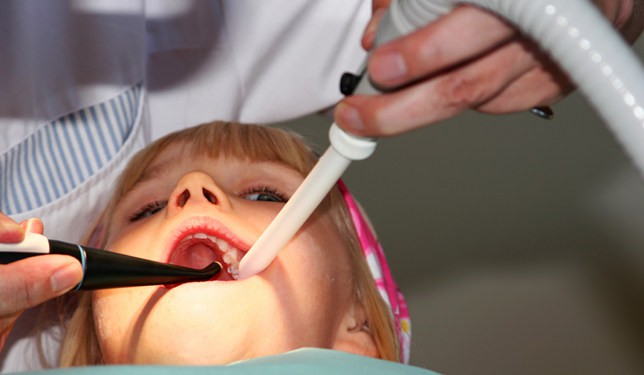
Why Dentists Use a Dental Suction
Now that the introductions are over, let's talk about some of the different reasons why dentists will use a suction.
For Patient Comfort
Keeping the patient comfortable is a high priority. In response to Jeanny's question, we suction after giving anesthetic because the anesthetic has a bitter taste, and most patients prefer to rinse out with water and use the saliva ejector. Also, if the anesthetic sits in the back of your mouth for too long, it may start to slightly numb the back of your mouth and could give the patient a gagging sensation.
We will also use the suction to make sure that you don't get too much water in your mouth while we are working.
To Clean Away Any Excess Dental Materials
When a dental hygienist cleans and polishes your teeth, you can get a lot of cleaning paste in your mouth. We use the suction to help clean all of that away. Also, when dentists are do amalgam fillings, pieces of the soft amalgam can sometimes fall away from the tooth surface. We use the suction to help whisk them away.
To Keep The Tooth Dry
During some procedures, such as white fillings, it is important that the tooth stay clean and dry. The suction helps keep the tooth dry by sucking away any saliva, blood, and water that may have accumulated around the tooth. If the cavity went below the gum-line, then it's pretty likely that the gums will bleed during the filling.
To Help the Dentist See
As I mentioned in a previous article about the dental drill, the drill that dentists use to do fillings sprays out a lot of water to keep the tooth cool and clean. Unfortunately, that water can quickly build up in the mouth and get on the dental mirror. In order to ensure that the dentist can see the tooth while working on it, it's necessary to use the high volume suction to suck away all of that debris.
Those are the four main reasons that I came up with as to why dentists use the dental suction. In conclusion, let's take a look at a question that I asked my dental hygienist as a child.
Where Does The Stuff Go After It's Sucked Away?
I remember sitting in the dental chair in Dr. Arnold's office as a child wondering what happens to all of the stuff that gets sucked down the suction. Maybe I was hoping that the tooth fairy would somehow be able to save the bad part of my baby tooth that the dentist removed and put it back together once my tooth fell out. After gathering up the courage to ask, I think I was slightly disappointed by the answer.
After your saliva, tooth debris, etc. gets sucked away, it travels through the suction line to a vacuum separator that will separate out any solids. After that, your spit makes a journey down the pipes and into the sewer system.
It is now recommended that dentists install amalgam separators in their suction lines to separate out any dental amalgam and keep it from getting into the public sewer systems.
Questions?
Do you have any questions about why dentists use suction? Leave a comment below and I'll try to get back to you. Thanks for reading!
Related posts:
Source: http://feedproxy.google.com/~r/OralAnswers/~3/0fa7n_24w78/
implant teeth teeth implant cosmetic dental surgery maxillofacial surgeons dental surgeon
Cavities are contagious, research shows
dental clinic dentures dental implants what are dental implants implants dental
Byproducts of bacteria-causing gum disease incite oral cancer growth, study shows
dental implants surgery dental implants procedure tooth implant surgery oral surgery teeth dental surgery cost
Who Knew? Famous People Who Were Dentists!
Source: http://www.omfdental.com/blog/2014/famous/?utm_source=rss&utm_medium=rss&utm_campaign=famous
dentures implants dental extractions implant dentures gum surgery maxillofacial jaw surgery
Tuesday, April 29, 2014
Can a Sinus Infection Be Caused by a Tooth?
 A couple of years ago, I wrote a post discussing sinus infections, prompted by my wife's experience. She had severe tooth pain caused by a sinus infection. While that post discusses how a sinus infection can cause tooth pain, it never addressed the opposite question: Can a tooth cause a sinus infection?
A couple of years ago, I wrote a post discussing sinus infections, prompted by my wife's experience. She had severe tooth pain caused by a sinus infection. While that post discusses how a sinus infection can cause tooth pain, it never addressed the opposite question: Can a tooth cause a sinus infection?
Sinuses are simply chambers in your head that allow air to circulate to get warm and moist before it travels down to your lungs. Normally, the body is able to keep the sinuses clean and healthy, despite the dark, moist environment that bacteria love.
However, when conditions are right, bacteria can grow out of control in the sinuses, causing a sinus infection. One cause of sinus infections is the common cold. Interestingly enough, teeth can also cause sinus infections.
Before we get into a discussion on how teeth can cause sinus infections, we'll talk about where the sinuses are located.
Where Are Sinuses Located?
There are a few different sinuses located in the facial area — around the cheeks, nose, and above the eyes. The diagram below gives you a little better idea of where the sinuses are, and how they look when they are healthy, versus how they look when they are infected.
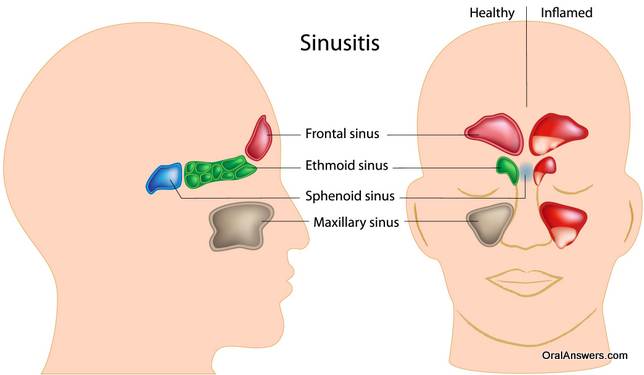
If you look at the diagram above and imagine a row of upper teeth, you can see how the roots of the upper teeth come into close contact with those sinuses on each side of the nose. These sinuses are known as the maxillary sinuses. While there are several sets of sinuses, the maxillary sinuses are the only sinuses that can also be infected by a tooth-related problem.
How Often Do Teeth Cause Sinus Infections?
Hupp's Contemporary Oral and Maxillofacial Surgery textbook states, "Periapical or periodontal infections of maxillary posterior teeth may erode superiorly through the floor of the maxillary sinus. Approximately 20% of cases of maxillary sinusitis are odontogenic."
Basically, that's a fancy way of saying that tooth and gum abscesses of the upper back teeth can eat through the bone and invade the maxillary sinus. It further says that about 20% of all maxillary sinus infections are caused by tooth infections, rather than another cause.
Below, you'll find a couple of examples of how tooth infections or abscesses can cause sinus infections.
A Case of an Abscess Close to the Sinuses
Here is an x-ray of a tooth that had a root canal and crown done previously, but the infection at the roots had never quite healed. I have outlined some of the important structures below for those of you who are not accustomed to reading x-rays.
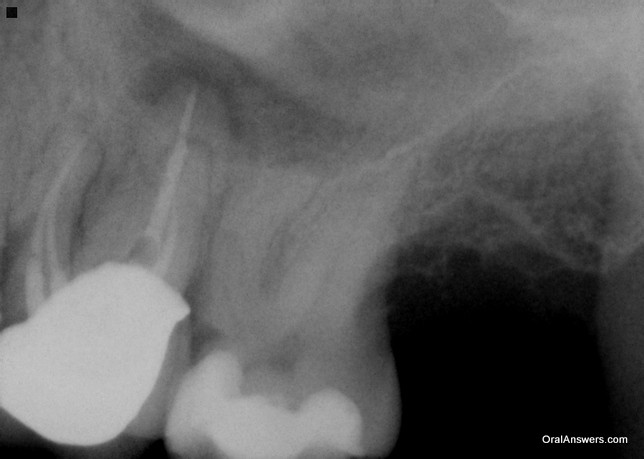
I colored the sinus blue and the tooth infection red in the x-ray below:
As you can imagine, the infection and the sinuses do overlap, as you can see in the x-ray below.
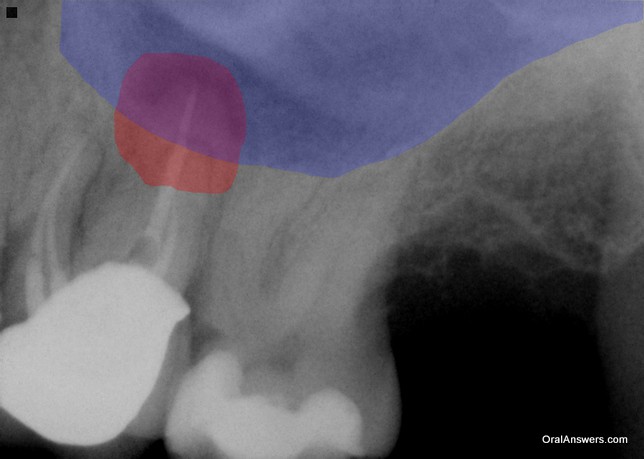
Although it looks like the sinus and the infection are overlapped on the x-ray, it doesn't necessarily mean that the infection has broken into the sinus and causing a sinus infection. It could be that the abscess is either in front of or behind the sinus in this x-ray, because the x-ray is simply a snapshot of the whole area and doesn't tell us if things are closer to the front or the back.
If you take a look at the x-ray above, you can see how close the maxillary sinus is to the upper teeth. Sometimes there is only a thin membrane separating the roots of the upper teeth and the sinus, making it very easy for an infection to travel into the sinuses.
Although this person wasn't exhibiting any symptoms of a sinus infection, but the x-rays do a good job of showing just how close the abscess is to the sinus.
A Case of Sinusitis Caused by a Tooth
This person had chronic sinusitis for the last few years, that started shortly after she had a metal post put into one of her upper back teeth. Upon looking at her x-rays I noticed that the metal post that was put in one of her upper teeth looked like it had pierced through edge of the tooth and gone slightly into the bone. This caused an abscess that was leaking into her sinus.
Here's the x-ray of her upper right teeth:
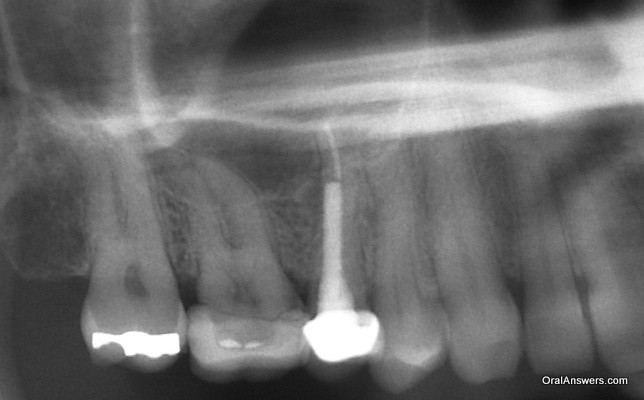
To make the x-ray below easier to see, the tooth is green, the infection is red, and the sinuses are blue:
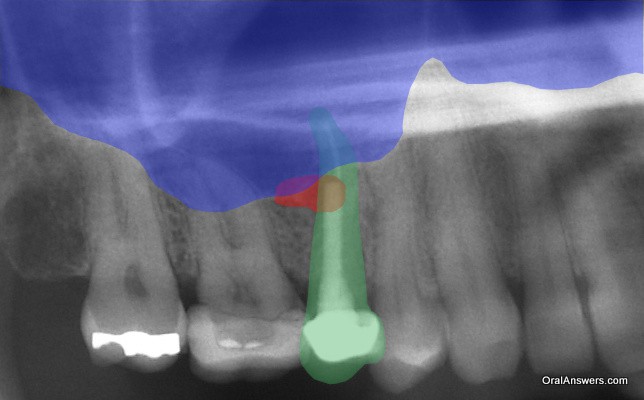
Sadly, due to the fracture in the tooth caused by the large metal post, the tooth had to be extracted.
The oral surgeon who extracted the tooth told me that the tip of the tooth broke off just above the metal post, causing the root fragment to get pushed into the sinuses during extraction. He had to open up the sinus to retrieve the root and he was able to suction out a lot of the infection — he said it was a pretty bad infection.
Teeth Can Cause Sinus Infections
While sinus infections can cause teeth to to hurt, hopefully this post has helped you see that infections from the upper back teeth can easily make their way into the sinuses and cause sinus infections.
It is important to remember that unhealthy teeth are just one cause of sinus infections, and that there are several other causes. If you suspect your sinus infection is caused by a tooth, you should see your dentist to confirm this.
Do you have any questions, concerns, or comments? Feel free to leave a comment in the comments section below. Thanks for reading!
Related posts:
Source: http://feedproxy.google.com/~r/OralAnswers/~3/lHL_YSpgOc4/
tooth extraction cost orthognathic surgery mini implants tooth replacement dentures implants
Dentistry: Resin infiltration effects in a caries-active environment -- two-year results
implants teeth teeth implants implant teeth teeth implant cosmetic dental surgery
Tooth loss linked to depression, anxiety
dental oral surgery dentalimplants maxillofacial surgery implants teeth teeth implants
Drug may guard against periodontitis, related chronic diseases
dental surgeon dental surgeons oral dental surgeon dental oral surgeon facial surgery
New method isolates immune cells to study how they ward off oral diseases
teeth implants implant teeth teeth implant cosmetic dental surgery maxillofacial surgeons
Researchers regenerate a fully functional bioengineered salivary gland
oral dentist surgery oral surgery dentist dentist oral surgery dental implant surgery mouth surgery
Monday, April 28, 2014
The antidepressant generation
Source: http://blogohj.oralhealthjournal.com/clinical/medical-news/the-antidepressant-generation
oral surgery dentist dentist oral surgery dental implant surgery mouth surgery tooth implant procedure
Researchers motivate diabetics to adopt healthy lifestyle
dental implant oral surgeon tooth extraction implant dentistry dental treatment
Tooth loss linked to depression, anxiety
60 Photos of Teenagers with Braces
Many teenagers wonder what they'll look like with braces, and what colors of rubber bands will look best with their hair color and facial tone. Judging by the comments on this article about braces colors, I decided it would be a good idea to create a post with dozens of pictures of teenagers with braces so you can get a general idea of how you'll look with braces.
As you take a look at the pictures below, you may notice that some people look confident with braces, and some people don't. If you try to smile and look proud of your braces, people will see you as more confident, and you'll likely enjoy having braces more. It all comes down to attitude.
Hopefully there's someone here that looks similar to you!
60 Photos of Teenagers with Braces
#1
This blond young woman appears confident as she smiles, showing off a pink powerchain on her upper braces.
#2

This young man appears confident even though he wears glasses and his braces pop right out at you. Even with the braces and glasses, he proudly shows off blue and orange colored bands around his braces.
#3

This blond-haired, blue-eyed young woman smiles, showing off gray and green colored bands around her braces.
#4

This blond-haired, blue-eyed young woman sports silver-colored elastic bands around her braces.
#5
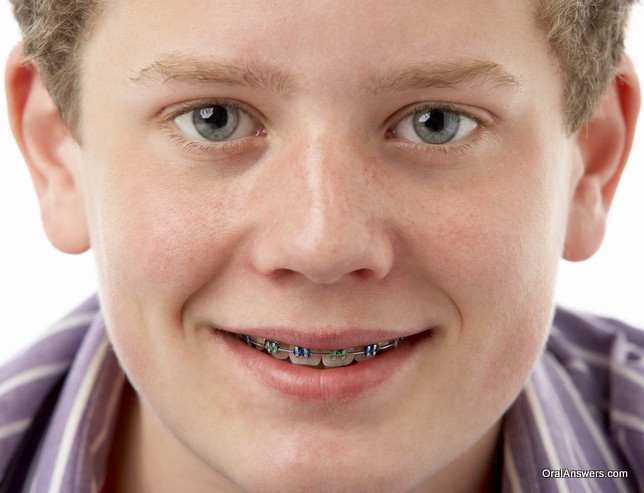
This brown-haired, blue-eyed young man is sporting blue and green colored elastics on his braces.
#6
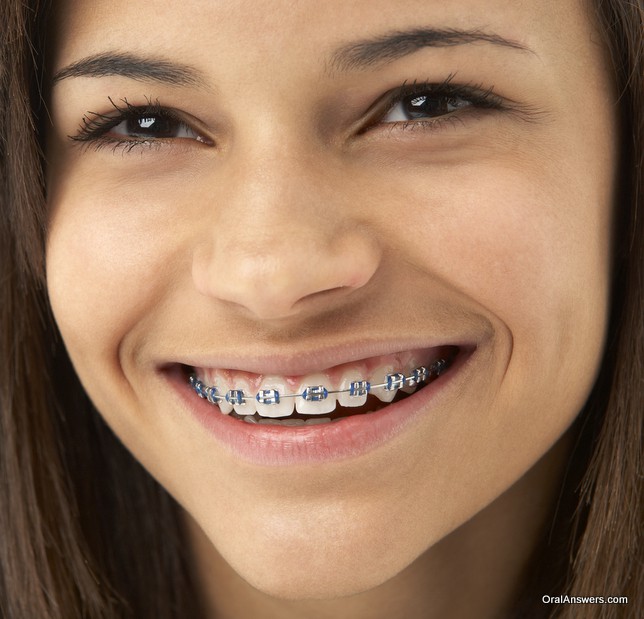
This young woman is proudly smiling, showing her blue elastics on her upper braces.
#7

This young woman is rocking a few different shades of blue elastics on her braces: light green, teal, and blue.
#8
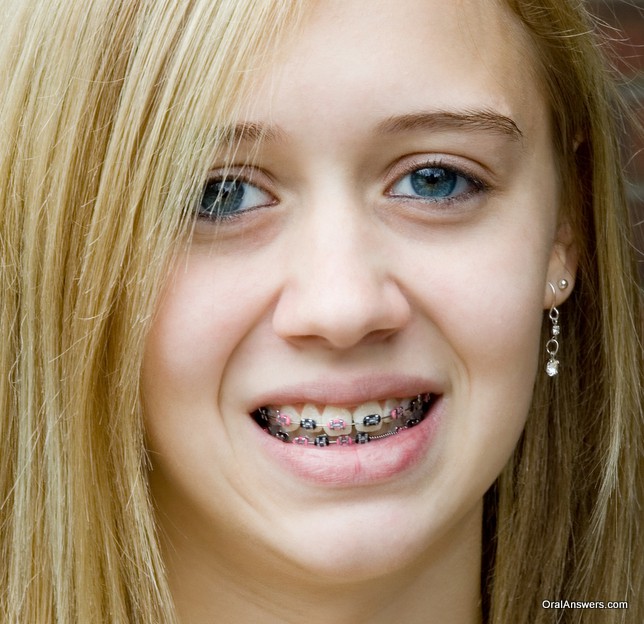
This blond-haired, blue-eyed young woman is smiling, displaying her upper and lower braces with black and pink-colored elastics.
#9

This young man is smiling enough that we can see his red elastic bands on his upper braces.
#10

This young woman is smiling big enough to show off her upper and lower braces with pink elastics.
#11
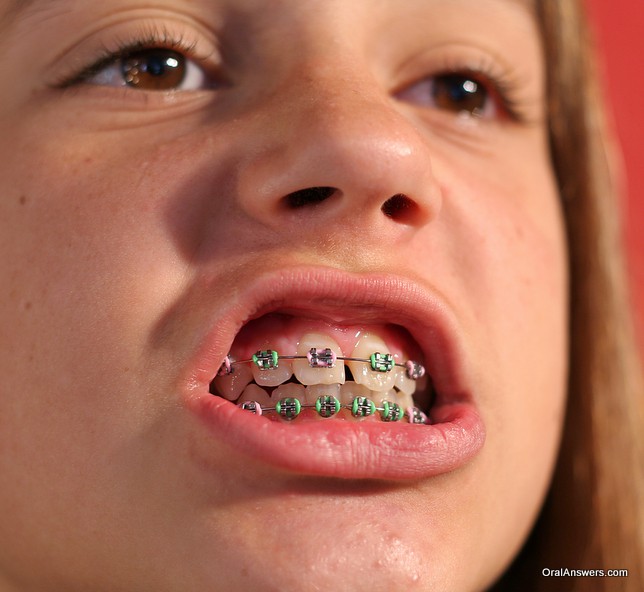
This young woman probably needs to work on her smiling skills! She's displaying pink and green colored elastics alternating on the top teeth with green bands on the lower four front teeth with pink bands next to them.
#12

This young man smiles, showing off blue-colored elastic bands on his braces.
#13

This young woman looks pretty happy with the world, showing off pink and green colored elastics.
#14

This young woman smiles revealing a silver powerchain that links the braces on her upper teeth.
#15
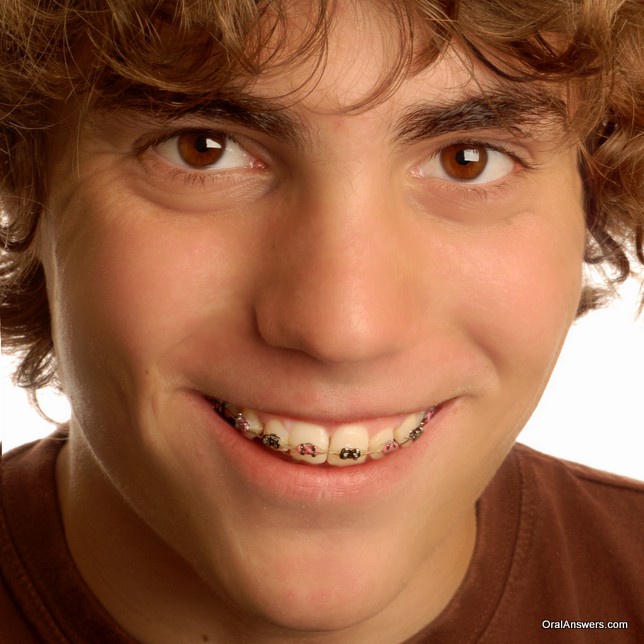
This young man isn't afraid to prove to the world that pink isn't just for girls.
#16

This young woman is seen sporting a popular choice for braces colors: pink and green.
#17

This young woman also thinks highly of the colors green and pink.
#18

This young man has chosen blue and green for his elastics.
#19

This young lady has chosen silver elastic bands that match the silver color of her braces.
#20

This young man displays a blue powerchain on his braces. He can't contain his large smile as he listens to an audio version of OralAnswers.com.
#21

This blond lifeguard rocks a pink powerchain.
#22

This young woman chose white elastics to help hide the silver color of her braces. Although white bands can be a good choice for some, many teenagers with braces find that they make their teeth look more yellow.
#23

This young man confidently smiles, unafraid to show the world that he has braces.
#24

This young woman has ceramic brackets, which don't stand out quite as much as the silver brackets.
#25
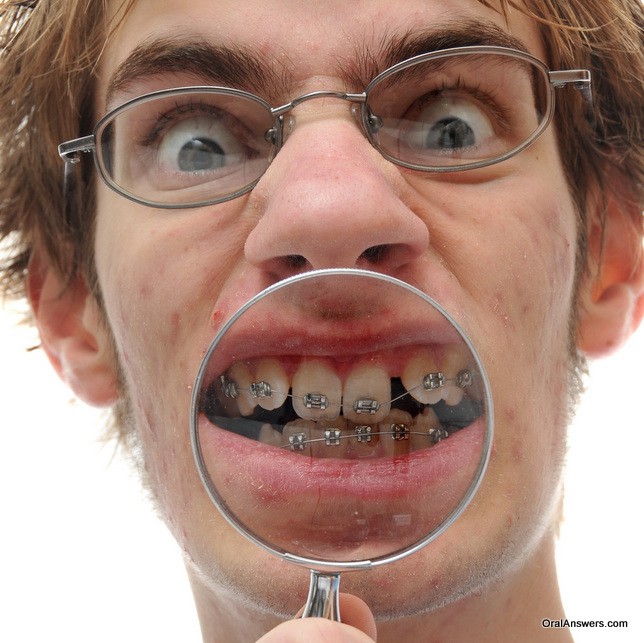
This young man isn't trying to hide the fact that he wears braces. His strategy seems to have garnered the interest of at least one woman.
#26

This fashionable young woman probably enjoys the bling her braces add to her outfits...and it looks like she can't stop looking at the attractive fellow in photo #25!
#27

This young woman confidently displays her braces for the world to see.
#28
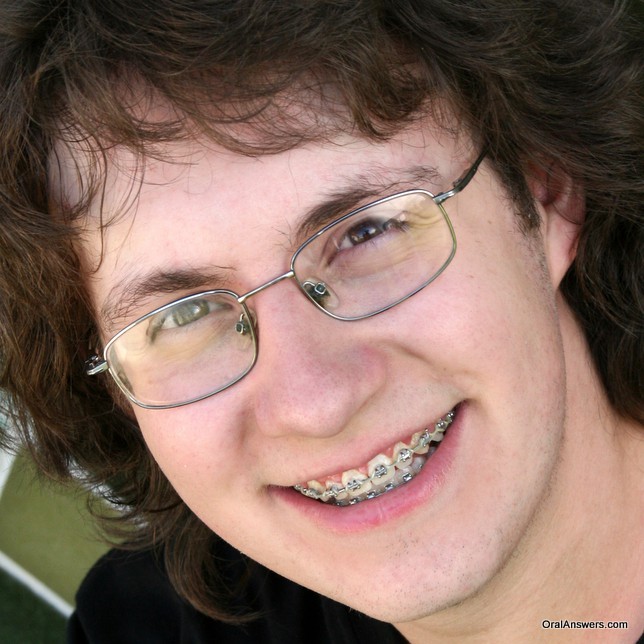
This young man's confidence goes a long way at convincing the viewer that he is comfortable with his braces.
#29

This young lady's mouth just needs some Christmas lights to be all ready for the holidays.
#30

This young brunette displays her top-notch oral hygiene skills by using an interdental cleaner to help keep her pearly whites healthy.
#31

This young man is having a fabulous hair day as he shows off his ceramic braces which are designed to hide the fact that the person has braces.
#32

This confident young woman shows off her braces.
#33

This young woman probably wouldn't be smiling so big if she knew she lost her braces wire.
#34

This young man confidently smiles, letting the world know that he's proud of his braces.
#34

This red-haired, blue-eyed young woman sports her Damon braces with confidence.
#35

This brown-haired young woman shows off her braces with purple-colored elastics.
#36

This young man proudly sports some light-green colored bands and a thin mustache.
#37

This dark-brown-haired young woman proudly shows off her braces.
#38

This young woman shows us through her big smile that it is possible to maintain beautiful teeth even while wearing braces.
#39

This young woman is trying to make her teeth appear whiter by going with an off-white elastic band.
#40

This teenage young lady shows that you can still look good during the initial phase of braces while your teeth are still crooked.
#41

This young lady shows off a sweet, innocent smile with her braces.
#42

This young woman shows off her Damon braces with a confident smile.
#43

This teenage girl recently had her braces put on. If we give her a few months, she'll soon move from a half-smile to a full, confident smile.
#44
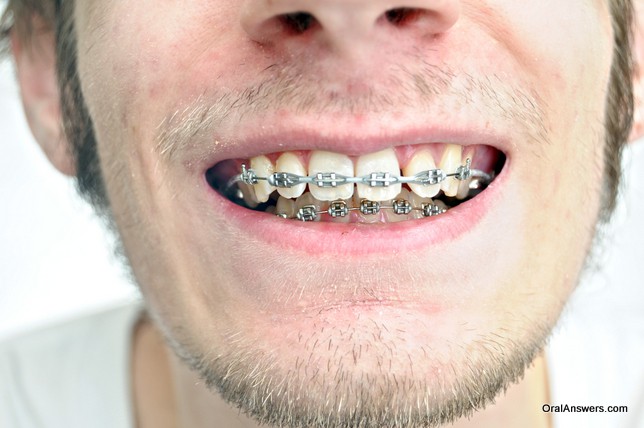
This young man is trying to distract from his braces with some facial hair.
#45

This young woman cleverly distracts the viewer from her braces to her eyes. One way to take the emphasis off of your braces is to guide the attention away from your mouth to other features. She does this with her eye shadow and her large earrings.
#46

This young woman's braces are barely noticeable. You can ask your orthodontist about more aesthetic options such as ceramic braces and lighter-colored wires.
#47
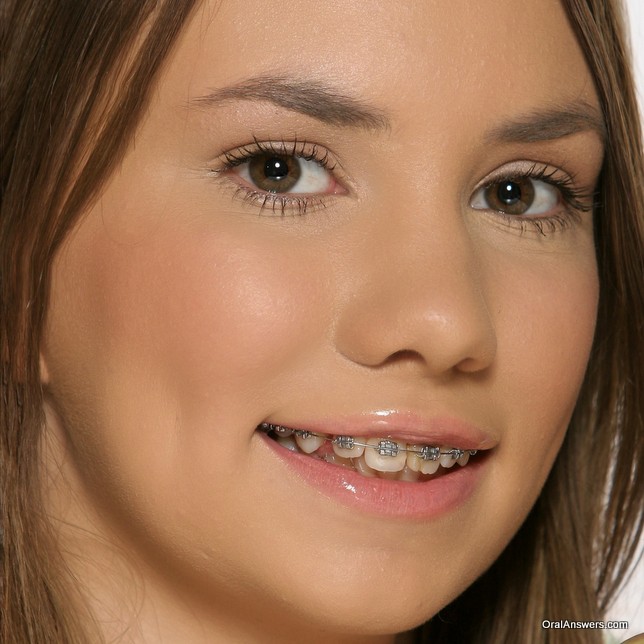
This teenage girl just got her braces, and is still getting used to smiling with them.
#48

This young man proudly shows off his gray and green colored elastic bands for his braces.
#49

This young woman displays a confident smile with her braces.
#50

These teenage girls are having fun swimming. It's important to remember that braces don't define who you are,!l Life continues to go on and you can participate in the same activities you did before you had braces.
#51 and #52

You can see the same teenager in the above and below photos. Notice how the different smile totally changes the appearance of her whole face. After you get braces, practice smiling and speaking in front of a mirror, as the braces will make your mouth feel different.
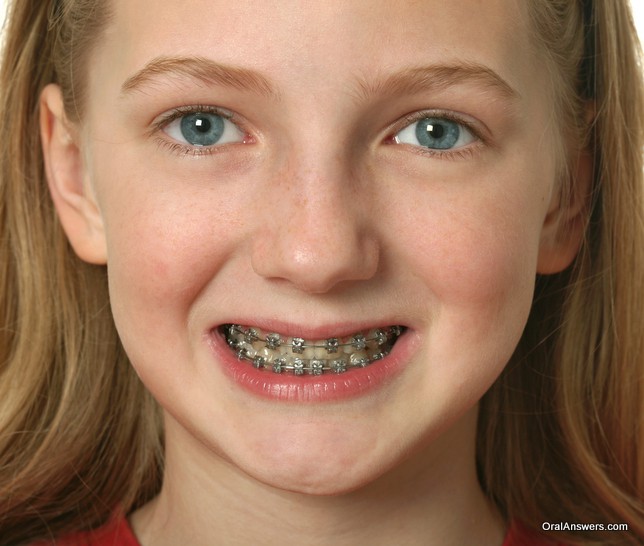
#53

This young man can confidently laugh at a joke. Don't be afraid to let people know you have braces, because they will probably notice even if you try to hide it.
#54
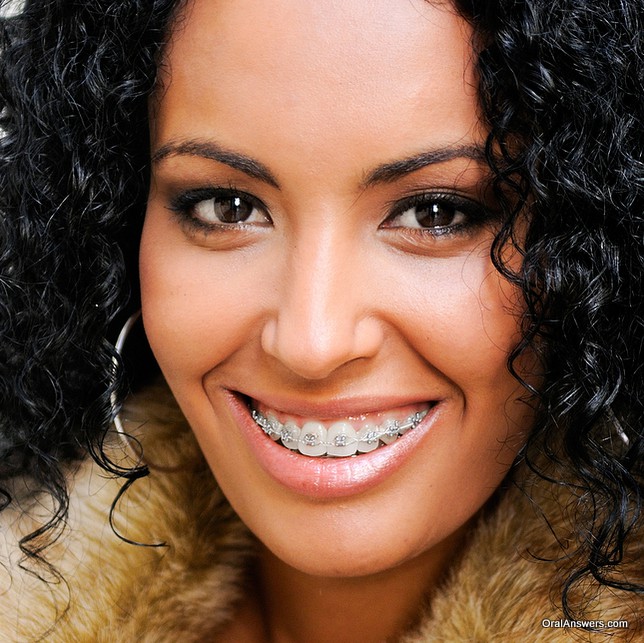
This young woman has consulted with her orthodontist about aesthetic optiosn to help disguise braces.
#55

This teenage girl has taken some of the focus off of her braces by wearing glasses that stand out with purple frames.
#56

This young lady is still working on getting her smile right with braces, as she's scrunching up her nose a little bit, causing more of her upper gums to show.
#57

This teenage boy proudly waves, desperate to show off his braces to anyone who will look.
#58

This teenage girl takes some of the focus off of her braces with some green eye shadow.
#59

This young blond-haired teenager proudly displays her braces with confidence.
#60

This young woman disguises her braces with a white powerchain.
Be Confident
Hopefully this sampling of photos of teenagers with braces has helped you see how you might look with braces.
One of the most important takeaways is to simply be confident with braces. They are temporary - they won't define who you are. You might as well be confident while you have them.
If you have any questions about braces, feel free to leave them in the comments section below. Thanks for reading!
Photos © Bigstock and ShutterstockRelated posts:
Source: http://feedproxy.google.com/~r/OralAnswers/~3/YOR-tPePmoI/
implant teeth teeth implant cosmetic dental surgery maxillofacial surgeons dental surgeon
